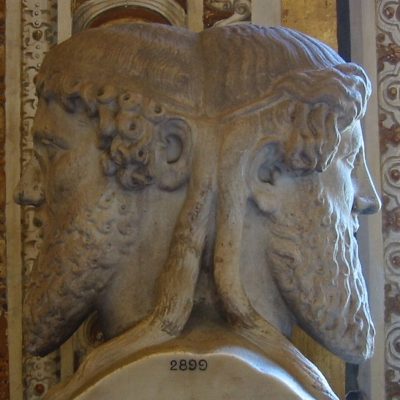In ancient Rome, the new year initially began on March 15 (the so-called ides of March), because at that time consuls (the most important state officials) took their office. Based on their term of office, the passing years were counted. That day also celebrated the festival of Anna Perenna – the Old Italian goddess of the New Year – which marked the beginning of spring. In order to celebrate this day, people went down to a valley near Rome (today’s piazza Euclide), where they celebrated and drank from the holy spring. Moreover, it was believed that if a woman made love in the valley for the first time, it would be a good omen for the future.
In 153 BCE – for reasons not entirely clear – there was a change and consuls were appointed from that day on January 1. However, thanks to Julius Caesar and his calendar reform, in 46 BCE, 1 January was established as the first day of the new year. From this moment, this day became a New Year’s holiday, in Italy and in all provinces of the empire.
The New Year in ancient Rome was called Calendae Ianuariae. The name of this event is due to the fact that the Romans called the first day of the month calendae. The name of the month (Ianuarius) is derived from the ancient Roman god of all beginnings with two faces – Janus. His character was symbolic – he had one face toward the previous year, and the other towards the new. In this regard, it was Janus who was the most important deity of the day and each Roman should make his first sacrifice to him. This guaranteed a good start to the year.
The New Year in Rome was greeted very solemnly and cheerfully as laeta dies. The Romans believed that if they spent the first day of the new year happily, so would it be the whole year. Therefore, they tried to spend the day as pleasant as possible. People wished for happiness through a kiss and a handshake. Sweet gifts (e.g. honey, dates, figs) were also given and eaten, believing that thanks to this all the days of the year will be equally sweet. Importantly, the gifts were initially rather modest and symbolic, such as twigs or laurel leaves. In the form of a gift, money was also given (a modest ace was a great gift, because one side of the coin had the image of Janus) or various valuable items, sometimes even with an inscription. Such a custom was not only in the lower social strata. Officials offered gifts to their subordinates, students to teachers and the poor to caregivers. The emperors accepted the gifts on certain days and they also reciprocated themselves. The gifts were called strenas.
For the new year, the door of the house was decorated with green branches, and in the evening with lamps. In the evening, great feasts were organized, to which many friends were invited. They played dice, and clusters of jugglers and jesters wandered around the house and extorting money. The streets, in turn, were loudly playing and singing, and the taverns were full of drunk and joyful Romans.
Ovid describes the New Year celebrations – in March – in honour of the New Year goddess – Anna Perenna (annus – year, perennis – eternal):
On the Ides is held the jovial feast of Anna Perenna not far from the banks,
O Tiber, who comest from afar,
The common folk come, and scattered here and there over the green grass they drink, every lad reclining beside his lass,
Some camp under the open sky; a few pitch tents; some make a leafy hut of boughs,
Others set up reeds in place of rigid pillars, and stretching out their robes place them upon the reeds,
But they grow warm with sun and wine, and they pray for as many years as they take cups, and they count the cups they drink.– Ovid, Fasti
New Year’s Day was also greeted extremely solemnly in private Roman homes. Simple people associated this event with divination and superstition. Gossip and quarrels should be avoided and the workload should not be overloaded. It was believed that if New Year’s day falls on the so-called nundinae (“market day”), the next year will be unhappy; if it falls on a Sunday, it was a fortune-telling war or the death of a high official; if on Monday – dying children and high prices; on Tuesday – fires and plagues and many, many others. Fortune-telling about the events that took place that day. For example, the death of emperor Caligula (killed by the Praetorian) was motivated by the fact that the bull he offered at the beginning of the fourth consulate (January 1) had no liver. People also read divination from Homer or Virgil’s books. They chose the poem that first looked and tried to bring out the fortune-telling.
In the house of each of the newly peeled two consuls, senators and friends gathered, and then a procession set off from the house, to which the inhabitants of the city joined. There was even a custom that consuls threw coins at the audience during the march. Both parades met in the Capitol, where Janus was sacrificed to bulls. The priests, in turn, sacrificed spelt to the god mixed with salt and traditional barley cake – called ianual. After this ceremony, the consuls organized a grand party for their friends in their homes. In addition, during imperial times, on the first day of the new year, officials pledged allegiance to the emperor and the army to their leader.
Certainly, the cheerful nature of the New Year’s celebrations was influenced by the festival celebrated on December 17 – Saturnalia – when universal equality and freedom existed in Rome referred to as libertas decembris. That day the master was equal to his slave, and all social injustices were gone.
It is impossible not to notice how much our New Year’s Eve has in common with the Romans’ celebrations of New Year. At that time, they were also having fun, rejoicing and giving presents. The elders played dice just like playing cards now. Certainly, Roman New Year celebrations have survived to this day.










